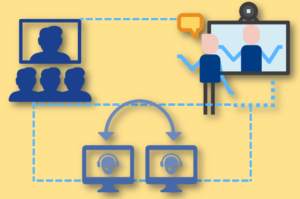A Scoping Review of Videoconferencing Systems in Higher Education
 Videoconferencing as a learning tool has been widely used among educators and learners in order to induce effective communication between learners and teachers or learners and their peers, especially when face-to-face means are not possible. Different types of videoconferencing platforms or systems have emerged for use in today’s higher education institutions. Previous research has focused on examining the potential of three different forms of videoconferencing systems: desktop videoconferencing (DVC), interactive videoconferencing (IVC), and Web videoconferencing (WVC). In this study, a review of the literature was conducted to increase the current knowledge regarding the use of these videoconferencing systems. A classification of the videoconferencing paradigms from the constructivism and cognitivism perspectives was provided. The summary of the results for these videoconferencing systems revealed specific learning opportunities, outcomes, and challenges for both learners and instructors. The results suggest that current policy and teaching strategies are not ready to provide an accessible and comprehensive learning experience in DVC and IVC. Relative to previously conducted studies regarding the use of videoconferencing in higher education, this study offers a broader consideration of relevant challenges that emerge when using certain videoconferencing systems in both learning and teaching situations.
Videoconferencing as a learning tool has been widely used among educators and learners in order to induce effective communication between learners and teachers or learners and their peers, especially when face-to-face means are not possible. Different types of videoconferencing platforms or systems have emerged for use in today’s higher education institutions. Previous research has focused on examining the potential of three different forms of videoconferencing systems: desktop videoconferencing (DVC), interactive videoconferencing (IVC), and Web videoconferencing (WVC). In this study, a review of the literature was conducted to increase the current knowledge regarding the use of these videoconferencing systems. A classification of the videoconferencing paradigms from the constructivism and cognitivism perspectives was provided. The summary of the results for these videoconferencing systems revealed specific learning opportunities, outcomes, and challenges for both learners and instructors. The results suggest that current policy and teaching strategies are not ready to provide an accessible and comprehensive learning experience in DVC and IVC. Relative to previously conducted studies regarding the use of videoconferencing in higher education, this study offers a broader consideration of relevant challenges that emerge when using certain videoconferencing systems in both learning and teaching situations.
International Review of Research in Open and Distributed Learning







